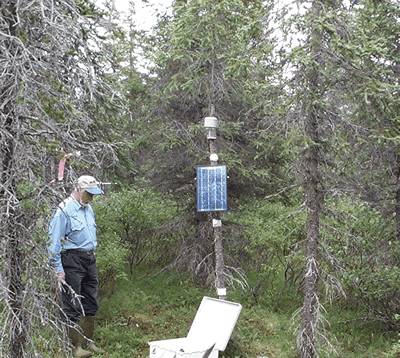Transitions: A study of the spatial and temporal transitions of climate and ecosystems in the circumpolar Arctic.
Project Personel
Main Contact: William Cable
Scientific Personel: V. E. Romanovsky, T. E. Osterkamp, and D.O.Sergueev, in collaboration with A.D.McGuire (Alaska Cooperative Fish and Wildlife Research Unit), F.S.Chapin (Institute of Arctic Biology, UAF), and Q.Zhuang (Department of Biology and Wildlife ).
Collaborators:
Partner Organizations:
Project Summary

This is a cooperative project with scientists from the Cooperative Institute for Research in Environmental Sciences, University of Colorado-Boulder, Boulder CO, from the Institute of Arctic Biology University of Alaska Fairbanks, and from the Division of Climate and Global Dynamics National Center for Atmospheric Research, Boulder CO. This project takes a comprehensive approach to the study of land surface energy and moisture budgets, involving both data collection, detailed data analysis, model development, and spatial and temporal extrapolation. As such, this project represents a new approach to interdisciplinary research, in which the field program, both ecological and physical, is closely tied to the simulation of ecosystems and climate systems.
This project takes a comprehensive approach to the study of land surface energy and moisture budgets, involving both data collection, detailed data analysis, model development, and spatial and temporal extrapolation.
Our work is driven by the hypothesis that the transition regions of Arctic climate and ecosystems (e.g. polar front, boreal forest treeline) have surface energy budget characteristics that are not well understood and that these characteristics have profound implications for changed ecosystems, permafrost, snow and atmospheric circulation distributions under a changing climate.
In order to produce credible predictions of these distributions for the entire Arctic, it is necessary to investigate these characteristics, determine parameterizations for their efficient modeling and incorporate these new parameterizations into spatially explicit predictive models.
To do this, we will employ a hierarchy of modeling approaches, including highly detailed stand-alone permafrost, vegetation and land surface models, column atmospheric models, vegetation dynamics models and regional and global climate system models.
This project started in May 1998. During this period of time, we installed equipment for temperature and soil moisture measurements in the active layer and near-surface permafrost at four sites near Ivotuk, North Slope of Alaska. This equipment will provide hourly data for analysis. We successfully incorporated our one-dimensional finite difference soil thermal model into the Terrestrial Ecosystem Model (TEM) of A. D. McGuire and colleagues. This coupled model was successfully tested for the old black spruce ecosystem in several regions in North America.


